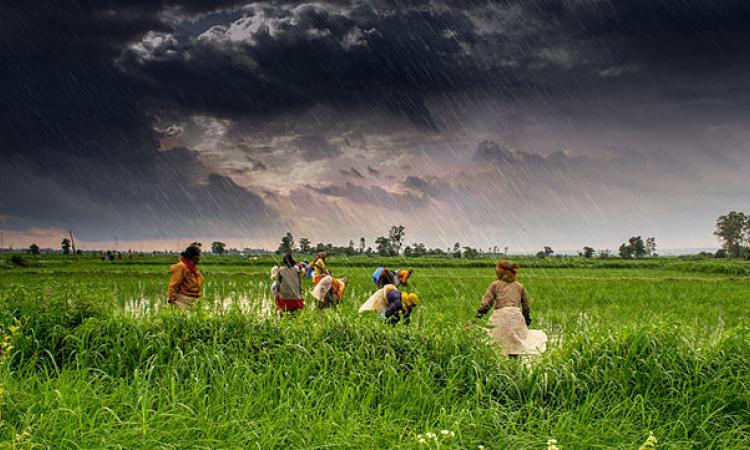
Climate change is one of the most complex and challenging environmental threat faced by the world and has been affecting ecosystems in major ways. It is predicted that the global temperature may rise by 1.5– 2.0 °C over the next decade and lead to increase in heat waves, longer warm seasons, and shorter cold seasons.
Climate change and agriculture
These changes in climatic factors such as temperature, rainfall, solar radiation, relative humidity, and carbon dioxide concentration can have a direct impact on agriculture informs this paper titled 'Assessment of long-term climate variability and its impact on the decadal growth of horticultural crops in central India' published in the journal Ecological Processes. Evidence shows that variations in climate can affect almost 60 percent of yield influencing crop production.
India is more vulnerable to climate risks due to its diverse climatic zones, ecosystems, and topography. The state of Madhya Pradesh, located in the central part of India is also experiencing droughts, excessive rains, floods, and hail storms due to climate change. Many districts of Madhya Pradesh are facing challenges such as late arrival of rains, early withdrawal, long break in rainfall spell, and lack of sufficient water in reservoirs, which adversely affect crop production.
Madhya Pradesh has a cultivated area of 14.9 million ha and majority of the area (62 percent) is under the rainfed agriculture with most of the precipitation received during the monsoon, making this area even more prone to climatic variability. The state is rapidly diversifying into horticulture with 6 percent of the gross cropped area of the state being under horticulture cultivation.
Some of the major horticultural crops grown are fruit crops (mango, guava, banana, oranges, papaya), vegetable crops (potato, onion, peas, tomato, cucurbits, brinjal, cabbage), spices (chillies, garlic, coriander, ginger) and flower crops (marigold, gaillardia, rose, gladiolus). Vegetable crops dominate with about 45 percent share in the area, followed by spices at 35 percent, fruits at 18 percent, and flowers contributing 2 percent.
Impact of climate change on horticulture in Madhya Pradesh
Extreme climatic factors are known to influence production of horticultural crops due to their adverse effects on flowering, fruit development, fruit quality, and pest-diseases infestation. However, there are no studies on the long-term impact of climate change on the area expansion and production of horticultural crops in this region. The paper discusses the findings of a study that focuses on long-term trends observed in annual precipitation and temperature, and its effect on horticultural crop production in Madhya Pradesh.
The study shows that:
The upward trend in maximum and minimum temperature may pose challenges to horticultural production in Madhya Pradesh in the years to come. For example, horticultural crops grown in Khargone, Balaghat and Bhind are vulnerable due to high mean temperature and low rainfall. Increasing trend of mean temperature for Hoshangabad, Jabalpur, Sagar and Rewa districts makes these districts even more vulnerable for horticultural crops.
The projected rise in temperature is of concern as it may directly influence the flowering in fruit crops like mango and guava. High temperature along with low relative humidity during the peak blooming period in mango leads to higher transpiration rate resulting in dehydration and reduction in yield. There are chances of increase in pests and diseases due to hot and humid conditions particularly, due to infestation of insects like fruit flies.
High temperature can also increase the plant maturity rates in fruits such as bananas shortening the bunch development period. Vegetables are even more susceptible to high temperature because of their succulent nature. For example, in tomatoes, high temperatures can cause yield losses due to reduced production and smaller size. Higher temperatures can lead to bud drop, abnormal flower development, poor pollen production, dehiscence, and viability, ovule abortion and poor viability, reduced carbohydrate availability, and other reproductive abnormalities in tomatoes.
In cucumber, low temperatures helps female flower production, whereas high temperatures lead to production of more male flowers hindering production. High temperature shortens the duration of onion bulb size leading to reduced yields.
Rabi cash crops will also be affected due to climate change in the state. Potato is another cash crop which is likely to be affected by climate change due to adverse effects on physiological processes. The rise in temperatures can also lead to physiological disorders in mangoes, litchies, vegetables and flower crops.
Under a warmer climate, the horticultural crops may experience severe water stress due to the decline in soil moisture and increase in evapotranspiration, leading to severe crop water-stress conditions. Also, the climatic variability will influence the soil fertility status, pest and disease occurrences, host- pathogen interactions, soil microbial population and behaviour of the pollinators which affect the crop yield.
The study shows that while the area and production of horticultural crops in Madhya Pradesh has grown in the last decade (2010–2020), with a slight decline in the area during 2013–2014 and in the production in 2015–2016, the state is susceptible to climate change which may affect crop production in the future negatively. There is thus a need to have a proactive approach to cope with future climate change that may lessen the extent of horticultural losses in the state.
Thus, strategies like development of cultivars tolerant to high temperature, moisture stress, pests and disease resistant, short duration and high yielding, as well as technologies like precision horticulture will help in addressing these challenges.